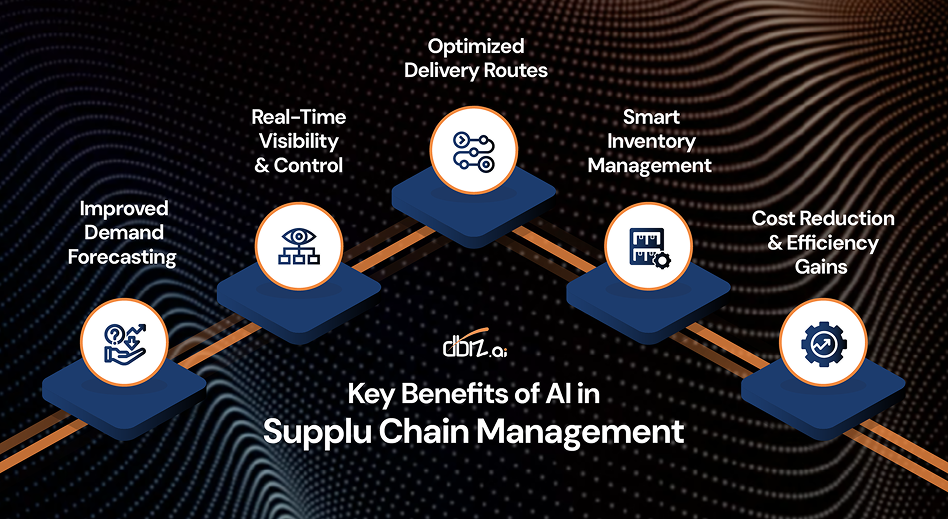Table of Contents
Introduction to AI-Powered Supply Chain Optimization
In today’s rapidly evolving global market, supply chain disruptions, rising costs, and shifting customer demands challenge businesses daily. Traditional supply chain models are no longer sufficient. Enter AI-powered supply chain optimization—a transformative approach that leverages artificial intelligence to enhance efficiency, minimize risk, and deliver measurable cost savings across operations.
What Is AI-Powered Supply Chain Optimization?
AI-powered supply chain optimization involves using artificial intelligence (AI) systems and algorithms to analyse vast amounts of real-time and historical data, automate decision-making, and continuously improve logistics processes. These systems identify patterns, forecast trends, and respond quickly to disruptions—making supply chains smarter, more resilient, and more responsive.
Key Benefits of AI in Supply Chain Management

- Improved Demand Forecasting
By analyzing historical data, market trends, weather patterns, and even social media signals, AI can predict customer demand with unprecedented accuracy. This prevents stockouts and excess inventory, ensuring optimal inventory management and higher service levels. - Real-Time Visibility and Control
AI systems leverage real-time data from IoT sensors, GPS, and ERP systems to monitor the global supply chain continuously. This visibility enables companies to reduce costs by identifying bottlenecks early and rerouting logistics to avoid delays. - Optimized Delivery Routes
AI algorithms evaluate delivery routes, traffic conditions, and driver behaviour to recommend the fastest, most efficient paths. This not only reduces fuel usage and emissions but also ensures faster delivery and greater customer satisfaction. - Smart Inventory Management
Using AI tools, companies can manage inventory levels across multiple warehouses and retail points. AI detects shifts in demand patterns, helping maintain the ideal stock without tying up capital unnecessarily. - Cost Reduction and Efficiency Gains
From automated procurement to predictive maintenance of assets, AI systems drive significant cost savings. They optimize labour allocation, identify inefficiencies, and continuously adapt to changes without human intervention.
Real-World Applications of AI in Supply Chains
Companies like Amazon, FedEx, and Uber Freight are already reaping the benefits of AI in supply chain operations.
- FedEx uses AI to optimize delivery times and logistics networks.
- Uber Freight utilizes machine learning for predictive freight pricing and intelligent load matching.
- Startups like PackageX.io and AireApps.com offer AI-based logistics and warehousing tools for mid-sized businesses.
These implementations showcase AI’s ability to enhance supply chain operations and offer a clear roadmap for businesses ready to innovate.
Overcoming Challenges with AI Integration

While the benefits are clear, integrating AI into legacy systems comes with hurdles:
- Data Quality:
AI relies on clean, structured, and relevant data - Change Management:
Teams must adapt workflows and upskill to work alongside AI systems. - Initial Costs:
Investment in technology and training is required, though ROI is typically high.
Overcoming these challenges requires a strategic approach—assessing current systems, identifying pain points, and building a roadmap that aligns AI tools with business goals.
Future of AI in Supply Chain Optimization
Looking ahead, AI will become more embedded in core supply chain platforms. Digital twins will simulate entire supply chain ecosystems. Generative AI will suggest responses to disruptions before they happen. And as more real-time data becomes available, decision-making will become increasingly autonomous. AI’s evolution means organizations that invest now will lead tomorrow.
Conclusion
AI-powered supply chain optimization is no longer a futuristic concept—it’s a present-day necessity. By harnessing artificial intelligence (AI) to manage supply chains more efficiently, businesses can minimize costs, increase visibility, and respond to disruptions proactively. Whether you’re a logistics giant or a scaling enterprise, the time to leverage AI in your supply chain is now.
Frequently Asked Questions
1. What is AI-powered supply chain optimization?
AI-powered supply chain optimization is the use of artificial intelligence and machine learning algorithms to improve decision-making, automate processes, and enhance efficiency across the entire supply chain. It analyses real-time and historical data to optimize inventory, demand forecasting, logistics, and supplier management.
2. How does AI improve inventory management?
AI improves inventory management by forecasting demand with greater accuracy, analysing sales trends, and monitoring real-time stock levels. This ensures optimal inventory levels, reduces stockouts and overstock, and helps businesses respond swiftly to changes in customer demand.
3. Can AI help reduce supply chain costs?
Yes, AI significantly reduces supply chain costs by automating manual processes, optimizing delivery routes, minimizing waste, and identifying inefficiencies. AI systems also enable predictive maintenance and smarter procurement decisions, contributing to overall cost savings.
4. What industries benefit most from AI in supply chain management?
Industries such as retail, manufacturing, logistics, healthcare, and e-commerce benefit greatly from AI-powered supply chain optimization. These sectors handle large volumes of data and rely heavily on real-time decision-making and accurate forecasting.
5. Is it difficult to implement AI in existing supply chain systems?
Implementing AI can be complex, especially for companies with legacy systems. However, starting with pilot projects, ensuring data quality, and partnering with experienced AI vendors or consultants can ease the transition and lead to successful integration over time.
Explore other articles:

AI-Driven Customer & Partner Portals
Personalized, intelligent portals enhancing engagement, collaboration, and efficiency with customers and partners.

Supply Chain Visibility & Transparency Solutions
Enhances real-time tracking, data sharing, and insights across the entire supply chain.

Low-Code Port Community Systems (PCS) for Paperless Ports
Build scalable, secure, and efficient maritime applications faster with low-code technology.


